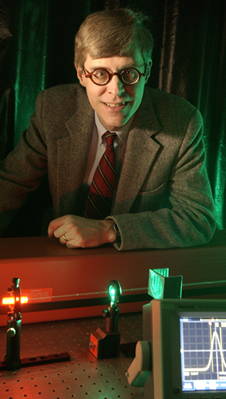About
22 February 2023
Optica awards Robert Boyd the 2023 Frederic Ives Medal/Jarus W. Quinn Prize
WASHINGTON — Optica (formerly OSA), Advancing Optics and Photonics Worldwide, has named Robert Boyd, University of Ottawa, Canada and University of Rochester, USA, the 2023 Frederic Ives Medal/Jarus W. Quinn Prize recipient.
Boyd is recognized for pioneering contributions to nonlinear optics, including slow light, quantum imaging, and the development of nanocomposite optical materials and metamaterials.
"Bob Boyd is an internationally renowned leader in nonlinear optics whose work has led to critical advances across multiple areas of optics," said Michal Lipson, Optica's 2023 President. "Congratulations on this well-deserved honor."
First presented in 1929, the Frederic Ives Medal recognizes overall distinction in optics and is Optica’s highest award. The Quinn Prize was added in 1995 in honor of Optica’s first Executive Director, Jarus W. Quinn.
Boyd received his B.S. degree in physics from Massachusetts Institute of Technology, USA and his Ph.D. from the University of California at Berkeley, USA. His thesis was supervised by Charles Townes and involved the use of nonlinear optical methods in astronomy. He joined the faculty of the University of Rochester in 1977. In 2010, he became Professor of Physics and Canada Excellence Research Chair in Quantum Nonlinear Optics at the University of Ottawa, while retaining his ties with the University of Rochester.
A giant in the field of nonlinear optics, Boyd has significantly impacted the areas of slow and fast light, quantum imaging, and composite materials and metamaterials. His early career work produced insights in four-wave mixing, quantum interference, and competition among nonlinear optical processes. He established the importance of Rabi oscillations, an atomic quantum effect that depends on the intensity of the applied optical field, and pioneered the field of optical instabilities in passive nonlinear systems. Boyd has been a key leader in the engineering of extreme and exotic indices of refraction. He showed that by properly preparing a nonlinear medium, light could be slowed to walking speed, could seem to exit before it entered a medium, or could even appear to move backwards in time. He succeeded in mechanically coupling light to a rotating medium, thus demonstrating the transfer of angular momentum between the two.
Boyd is author of the authoritative textbook, Nonlinear Optics, many highly cited papers, and has 9 US patents. An outstanding volunteer he has served on Optica committees and councils for nearly 40 years, including award selection committees, Frontiers in Optics Program Committee, Nonlinear Optics Program Committee and the Meetings Council. He was a member of the Optica Board of Directors and editor or guest editor for Applied Optics, JOSA B, Optical Materials Express and Optics Express.
He is a Fellow of Optica, Royal Society of Canada, and IEEE, and has won several awards including Optica’s Charles Hard Townes Medal, the Arthur L. Schawlow Prize in Laser Science, and the Humboldt Research Award.
About Optica
Optica, Advancing Optics and Photonics Worldwide, is the society dedicated to promoting the generation, application, archiving and dissemination of knowledge in the field. Founded in 1916, it is the leading organization for scientists, engineers, business professionals, students and others interested in the science of light. Optica's renowned publications, meetings, online resources and in-person activities fuel discoveries, shape real-life applications and accelerate scientific, technical and educational achievement. Discover more at: Optica.org
Media Contact
